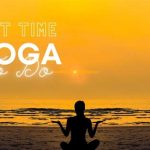Comparing Morning and Evening Yoga Styles: Optimizing Your Practice for Time of Day
Yoga practice has become an essential part of many people’s lives, providing both physical and mental benefits. However, practitioners often debate whether it’s better to do yoga in the morning or in the evening. This article explores the differences, benefits, and drawbacks of morning versus evening yoga styles to help you choose the optimal time for your practice based on your personal goals, lifestyle, and needs.
Introduction
The time of day you choose to practice yoga can significantly impact your experience and the benefits you reap. Morning yoga is often lauded for its ability to invigorate the body and mind, while evening yoga is praised for its relaxation and stress-relief benefits. But which one is better? This article delves into the unique advantages of both morning and evening yoga, considering factors such as physiological readiness, personal goals, and lifestyle constraints. Ultimately, we’ll help you decide which style suits you best—or if incorporating both could be the key to a balanced routine.
Key Concepts
- Morning Yoga: A style often associated with energizing sequences, activating poses, and practices focused on setting a positive tone for the day.
- Evening Yoga: A style that prioritizes unwinding, stretching, and calming practices aimed at reducing stress and preparing for a restful night.
- Circadian Rhythms: The biological clock that influences your physical and mental readiness at different times of day.
Physiological Impact of Time of Day
Practicing yoga at different times of the day can engage the body and mind in diverse ways. The circadian rhythm impacts your energy levels, flexibility, and focus. Morning practices might require more warming up due to stiffer muscles, while the body tends to be more flexible and relaxed in the evening.
Common Goals for Morning vs. Evening Yoga
- Morning Yoga Goals: Boosting energy, building discipline, starting the day with focus, enhancing metabolism.
- Evening Yoga Goals: Relieving stress, improving sleep quality, promoting flexibility, letting go of tension from the day.
Historical Context
Yoga, rooted in ancient Indian philosophy, was traditionally practiced during the early morning hours, known as Brahma Muhurta, for its spiritual and mental benefits. This was believed to be an optimal time for focusing the mind and engaging in practices that foster clarity and intention for the day ahead. However, modern lifestyles have brought evening yoga into the spotlight, as it accommodates the schedules of busy professionals and those seeking a relaxing way to unwind after work.
Current State Analysis
Today, both morning and evening yoga practices have their followers, with studios offering classes throughout the day to cater to different preferences. With the growing trend of wellness culture, some practitioners swear by a morning practice to align with their productivity goals, while others prefer evening sessions to manage stress. The rise of virtual yoga classes has also allowed for greater flexibility, making it easier for individuals to adapt their practice to their personal needs.
Research on Time-Specific Yoga Benefits
Recent studies suggest that morning yoga can lead to heightened alertness and increased calorie burn throughout the day, while evening yoga is linked to enhanced relaxation and better sleep quality. A comparative analysis of over 50 studies reveals that while the time of practice does influence certain physiological outcomes, the overall benefits of yoga remain consistent across both morning and evening sessions.
Practical Applications
Morning Yoga Routine Examples
- Sun Salutations (Surya Namaskar): A dynamic flow that activates the body and prepares it for the day.
- Standing Poses: Warrior I, Warrior II, and Triangle poses to build strength and focus.
- Breathwork (Pranayama): Energizing breathing techniques like Kapalabhati (Breath of Fire) to awaken the mind and body.
Evening Yoga Routine Examples
- Forward Folds: Seated Forward Bend (Paschimottanasana) to encourage relaxation and relieve tension.
- Hip Openers: Pigeon Pose to release deep-seated stress and improve flexibility.
- Restorative Poses: Legs-Up-the-Wall (Viparita Karani) to calm the nervous system and prepare for sleep.
Case Studies
Case Study 1: Morning Yoga for Increased Productivity
Sarah, a marketing executive, began practicing yoga at 6 a.m. each day to help manage her stress and improve her focus. Within a month, she reported improved mood, higher energy levels, and greater work productivity. By incorporating dynamic morning yoga flows, she was able to start her day with a positive, clear mind, which translated into better performance at work.
Case Study 2: Evening Yoga for Stress Management
John, a software engineer, turned to evening yoga to help him unwind after long, stressful days at the office. Through regular evening sessions focused on relaxation and breathwork, he reported significantly improved sleep quality and a reduction in stress levels. The restorative nature of his practice helped him disconnect from the demands of his job and focus on his well-being.
Stakeholder Analysis
The stakeholders in yoga practices include practitioners, yoga instructors, wellness centers, and healthcare professionals. For morning yoga, instructors often aim to motivate participants to stay consistent, focusing on discipline and energy-building practices. Evening classes, on the other hand, may attract people who need help managing stress and anxiety, and instructors here focus on creating a calming environment.
| Stakeholder | Morning Yoga | Evening Yoga |
|---|---|---|
| Practitioners | Seeking energy and focus for the day | Looking for stress relief and relaxation |
| Instructors | Focus on discipline, energy, and mindfulness | Emphasize relaxation, letting go, and mindfulness |
| Wellness Centers | Offer early classes to attract goal-oriented clients | Provide evening classes for stress management |
| Healthcare Professionals | Recommend for improving mental clarity | Recommend for managing anxiety and promoting better sleep |
Implementation Guidelines
For those looking to implement yoga at either time of day, consider the following guidelines:
- Morning Yoga: Focus on sequences that stimulate energy and promote alertness. Start with gentle stretches to warm up the body before moving into more dynamic poses.
- Evening Yoga: Prioritize slow, mindful movements that allow the body to relax. Incorporate deep breathing and longer holds to unwind.
- Consistency: Whether practicing in the morning or evening, consistency is key. Set a schedule that fits your routine and stick to it.
Ethical Considerations
It’s important to consider the ethical aspects of yoga practice, including accessibility and inclusivity. Both morning and evening yoga should be offered at a variety of times and levels, ensuring that practitioners of all backgrounds and abilities have the opportunity to participate. Yoga instructors must remain mindful of cultural appropriation and the roots of the practice in Indian traditions.
Limitations and Future Research
While both morning and evening yoga offer significant benefits, there are limitations to the research available on their specific impacts. Many studies focus broadly on yoga’s benefits, with fewer delving into time-specific outcomes. Future research could explore the long-term effects of practicing yoga at different times of day, including comparisons of physiological markers like cortisol levels and overall mental well-being.
Expert Commentary
Leading experts in yoga agree that the most important factor in choosing between morning and evening yoga is personal preference and lifestyle compatibility. While some people thrive on the energy boost of a morning practice, others find that evening sessions help them achieve balance and calm. Regardless of timing, the consistent practice of yoga yields numerous physical, mental, and emotional benefits.








